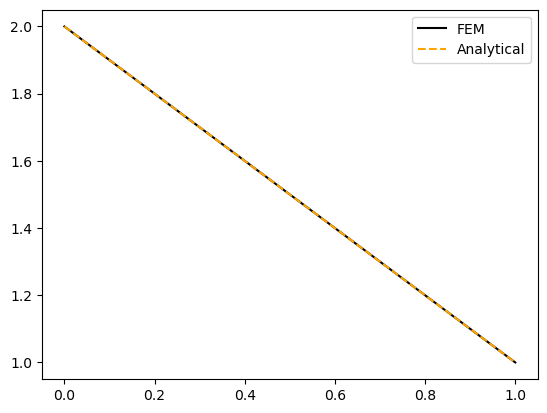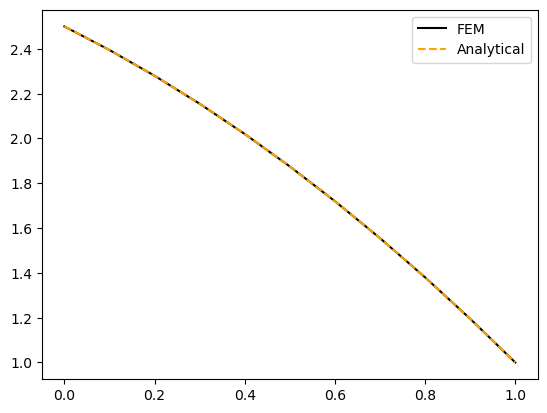Problem 7.10#
Let us consider the case with \(n\) elements (nodes from \(x_1\) to \(x_{n+1}\)). Because the final node (\(n+1\)) has its temperature is fixed, we do not need to solve for this node. The elements of the local diffusivity matrix for nodes \(1,...n\) are given in 7.60-7.62.
In Problem 7.9, it is shown that
which holds for \(A = 1,\, n\) inclusive.
Similarly the heat supply vector may be written as
where
For example, the local forcing vectors from the first 3 elements would be:
So now let us determine the values of \(f_a^A\) for the cases of \(h=0\) and \(h=1\) by solving Eqn 7.69,
Evidently \(f_a^A = 0\) when \(h=0\). When \(h(x) = 1\), we get
Case 1: h = 0#
Note here that the textbook has indices going from \(1\) to \(n\). Python indexes starting at 0 so our indices will be from \(0\) to \(n\) and the first element of a matrix will be \(K_{00}\).
import numpy as np
import scipy.linalg as sl
import matplotlib.pyplot as plt
# Boundary conditions:
theta_1 = 1
H0 = 1
nelem = 10 # number of elements, n
np1 = nelem + 1 # n+1
# Global domain node locations
x = np.linspace(0, 1, np1)
# Compute Delta x for each element:
dx = x[1:] - x[:-1]
# Create our diffusivity matrix:
K = np.zeros((nelem, nelem))
# Create global heating matrix:
F = np.zeros(nelem)
for ielem in range(nelem):
# Compute local diffusivity matrix for this element:
# using 7.65
kloc = np.zeros((2,2))
kloc[0,0] = 1
kloc[1,1] = 1
kloc[0,1] = -1
kloc[1,0] = -1
# Multiply by grid spacing
kloc *= (1/dx[ielem])
# Add to the global matrix:
if ielem == nelem -1:
# For the last element we are ignoring the
#contributions from the n + 1 node
K[ielem, ielem] += kloc[0,0]
else:
K[ielem:ielem+2, ielem:ielem+2] += kloc
# Create local forcing vector for element:
# In the case that h = 0, we know floc is also
# 0 except at the boundaries
floc = np.zeros(2)
if ielem == 0:
floc[0] += H0
elif ielem == nelem-1:
floc[0] += theta_1/dx[ielem]
# Add to the global vector:
# For the nth element we need to edit the
# indexing since only the nth (not n+1th) node
# is added
if ielem == nelem-1:
F[ielem] += floc[0]
else:
F[ielem:ielem+2] += floc
# Compute d as K^-1 * F
Kinv = np.linalg.inv(K)
d = np.matmul(Kinv, F)
# The total temperature field includes the n+1 node
# which is equal to theta_1
temp = np.zeros(np1)
temp[:-1] = d
temp[-1] = theta_1
We can now compare against the analytical solution
# Plot against analytical
# When h is 0:
analytical = theta_1 + (1-x)*H0
fig, ax = plt.subplots()
ax.plot(x, temp, 'k')
ax.plot(x, analytical, '--', color='orange')
ax.legend(['FEM', 'Analytical']);

Case 2: h = 1#
Now lets consider the case when \(h=1\). This does not affect the diffusivity matrix, only the force matrix, so lets update that and rerun the code:
# Reinitialise global heating matrix:
F = np.zeros(nelem)
for ielem in range(nelem):
# Create local forcing vector for element:
# In the case that h = 0, we know floc is also 0
# except at the boundaries
floc = np.zeros(2)
if ielem == 0:
floc[0] += H0 + dx[0]/2
floc[1] += dx[0]/2
elif ielem == nelem-1:
floc[0] += (theta_1/dx[ielem]) + dx[-1]/2
else:
floc[0] += dx[ielem-1]/2
floc[1] += dx[ielem]/2
# Add to the global vector:
# For the nth element we need to edit the indexing
# since only the nth (not n+1th) node is added
if ielem == nelem-1:
F[ielem] += floc[0]
else:
F[ielem:ielem+2] += floc
d = np.matmul(Kinv, F)
# The total temperature field includes the n+1 node
# which is equal to theta_1
temp = np.zeros(np1)
temp[:-1] = d
temp[-1] = theta_1
Finally, let us compare against the analytical solution (7.19) for \(h(x)=1\) which ends up being
fig, ax = plt.subplots()
# Analytical solution in this case
theta = theta_1 + (1-x)*H0 + 0.5*(1 - x**2)
ax.plot(x, temp, 'k');
ax.plot(x, theta, '--', color='orange');
ax.legend(['FEM', 'Analytical']);

